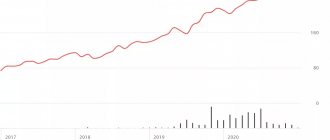Preferred shares (PA) are shares with a number of privileges. The owner of this type of securities is deprived of the right to vote at a meeting of shareholders, but receives certain privileges. They are what distinguishes an ordinary share from a preferred share. One of them is the receipt of constant income from securities. If the company cannot consistently pay dividends, the right to vote at the meeting is restored.
What are ordinary shares, how do they differ from preferred shares ?
Share privileges
Securities of this type are distinguished by the following privileges:
- Stable dividend payment.
- The right to part of the organization's property upon its liquidation.
- Probability of conversion into standard shares.
- The right to vote in the reorganization of the enterprise, restructuring, liquidation, amendments to the charter.
- Obtaining full voting rights in the event that the company can no longer make payments.
The main advantage of shares is the constant receipt of dividends.
the weighted average number of ordinary shares outstanding calculated ?
When does it make sense to issue preferred shares?
Any company needs financing. You can obtain the necessary funds in various ways. Stocks are one of those routes. They allow the company to receive the necessary funds, and shareholders to receive dividends, as well as participate in the management of the organization.
It makes sense to issue preferred shares in the following cases:
- The company has the resources to consistently pay dividends.
- The owners of the organization do not want to allow strangers to manage the company.
As a rule, PAs account for 25% of the total volume of securities. That is, they occupy an intermediate value between ordinary stocks and bonds. These shares prevent the emergence of a large number of shareholders with voting rights.
How are dividends paid on preferred shares ?
Pros and cons of such promotions
The main difference between preferred shares and ordinary shares is the limited voting rights at meetings of security holders, as well as the presence of privileges. Let's look at their benefits for shareholders:
- Preemptive right when distributing dividends.
- Preemptive right to receive funds in the event of company bankruptcy.
- The right to receive a specified amount of funds if the company makes a profit.
- The right to vote during liquidation and reorganization of an organization.
The main advantage of a company when issuing PAs is the limitation of the voting rights of shareholders in managing the organization.
Let's look at the disadvantages of PA:
- Limitation of voting rights in company management.
- Relatively small dividends.
For a company, the main disadvantage of preferred shares is the need for stable dividend payments.
CFA - Characteristics of preferred shares
Preferred shares (English 'preference shares', 'preferred stock') have priority over ordinary shares with regard to the payment of dividends and distribution of net assets upon liquidation of the company. However, preferred shareholders generally do not participate in the company's operating results and have no voting rights unless expressly permitted by the issue.
When a company is liquidated, preferred shares rank lower than debt. That is, debt holders have a senior claim on the firm's assets in the event of liquidation and will receive what is owed to them first, followed by preferred shareholders, and then common shareholders.
Preferred stock has characteristics of both debt securities and common stock. Like interest payments on debt securities, dividends on preferred stock are fixed and typically higher than dividends on common stock.
However, unlike interest payments, preferred dividends are not a contractual obligation of the company. Like common stock, preferred stock may be perpetual (that is, without a fixed maturity date), may pay dividends indefinitely, and may be redeemable by the issuer (callable) or by the holders (putable).
Illustration 9 contains an example of redeemable preferred stock issued by the GDL Fund to raise capital to purchase the remaining outstanding Series B preferred stock. In this case, the purchaser of the shares will receive a permanent dividend income from the GDL Fund.
If the GDL Fund decides to repurchase shares, it must do so at the preferred stock liquidation price of $50. Buyers of shares also have the right to return shares of GDL at a price of $50.
Illustration 9. GDL Fund Redeemable Preferred Shares.
RYE, NY - March 26, 2022 - GDL Fund (NYSE:GDL) (the "Fund") is pleased to announce a rights offering (the "Offering") in which the Fund issued 2,624,025 cumulative shares of Series C preferred stock, subject to issuer and holder redemption rights. (“Series C Preferred”), for a total of $131,201,250.
Pursuant to the Offering, the Fund issued one non-transferable right (a "Right") for each cumulative issuer and holder redeemable Series B Preferred Share (the "Series B Preferred") to holders of Series B Preferred Stock as of February 14, 2022.
Rightsholders have the right to purchase shares of Series C Preferred Stock for cash or through the liquidation of shares of Series C Preferred Stock held.
Therefore, to purchase each share of the Series C Preferred, one Right plus $50.00 or one Right plus one share of the Series B Preferred is required at the liquidation price of $50.00 per share.
Offer ends at 5:00 PM ET on March 20, 2018.
Dividends on preferred stock may be cumulative, non-cumulative, participating, non-participating, or a combination thereof (i.e., cumulative participating, cumulative non-participating, non-cumulative participating, non-cumulative non-participating).
Dividends on cumulative preference shares are calculated so that if a company decides not to pay dividends for one or more periods, then the unpaid dividends accrue and must be paid in full before dividends can be paid. ordinary shares.
In contrast, non-cumulative preference shares do not have such a condition. This means that any dividends that are not paid in the current or subsequent periods are considered forever lost and are not accrued for future payment.
However, the company still cannot pay any dividends to common shareholders in the current period unless preferred dividends have been paid.
Participating preference shares give shareholders the right to receive standard preferred dividends plus the option to receive additional dividends if the company's earnings exceed a predetermined level.
In addition, the participating preferred shares may also contain provisions that entitle shareholders to an additional distribution of the company's assets upon liquidation above the par value of the preferred shares.
Non-participating preference shares do not allow shareholders to receive a portion of the company's profits. Instead, shareholders are entitled to receive only fixed dividends and par value of shares in the event of liquidation.
Participating preferred shares are much more common among smaller, riskier companies whose investors are more concerned about the possibility of future liquidation.
Preferred shares may also be convertible.
Convertible preference shares allow shareholders to convert them into a specified number of common shares. This conversion ratio is determined at the time of issue. Convertible preferred shares have the following advantages:
- They allow investors to receive higher dividends than the company's ordinary shares.
- They give investors the opportunity to share in the company's profits.
- They allow investors to benefit from rising common stock prices through a conversion option.
- Their price is less volatile than common shares because dividend payments are known in advance and are more stable.
As a result of all this, convertible preferred stock is a popular financing option in venture capital and private equity transactions where the issuing companies are considered riskier and it takes years for the company to go public (that is, begin issuing common stock for public sale). .
Exhibit 10 provides examples of the types and characteristics of preference shares issued by Tsakos Energy Navigation Ltd (TNP.PRE).
Figure 10: Examples of preference shares issued by TEN Ltd.
Athens, Greece, June 21, 2022 - TEN Ltd. (“TEN”) (NYSE: TNP), a leading diversified oil and LNG tanker operator, today announced the pricing of its public offering of Series F cumulative preferred stock, perpetual, redeemable, fixed and variable rate dividends, at a price of $1.00 per share, with liquidating preferred stock price of $25.00 per share (the "Series F Preferred Stock").
TEN will issue 5,400,000 shares of Series F Preferred Stock at a price of $25 per share. Dividends on these shares will be paid until July 30, 2028 at a fixed rate of 9.50% per annum, and from July 30, 2028, if these shares are not redeemed, at a floating rate.
In connection with the offering, TEN has granted subscribers a 30-day option to purchase 810,000 shares of the additional Series F shares. If exercised in full, the total gross proceeds from the sale of the issue will be $155,250,000.
TEN intends to use the net proceeds from the offering for general corporate purposes, which may include the acquisition of tankers and/or strategic investments and repurchases of preferred shares.
Following the offering, TEN intends to file a Series F listing on the New York Stock Exchange. The offering is expected to close by June 28, 2022.
Varieties
Preferred shares are divided into the following categories:
- Regular PA . Holders of these securities receive benefits in exchange for voting rights. When distributing dividends, shareholders receive a priority right to receive payments.
- Cumulative or accumulating shares . These securities feature similar benefits. Their difference from ordinary PAs is the established period for accumulating dividends. If the funds are not received by the shareholder within the specified period, the person receives the right to vote at the general meeting.
An analogue of a PA is a founders' share. This is a security that can only be received by the founders of the company. The promotion provides a number of privileges:
- Additional votes at the meeting.
- Preemptive right to receive shares upon issue.
- Obtaining a leading role in resolving issues regarding the work of a joint-stock company.
Bearer shares imply free purchase and sale of these securities on the secondary market. In this case, there is no need to re-register the shareholder.
Special rights of owners of preferred shares
The main right is the right to receive dividends in the manner prescribed by the charter. In addition, holders of preferred shares have the right to participate in voting:
- on termination of the public status of the company;
- on the release of JSC from the obligation to disclose information about securities;
- on other issues, decisions on which are made by all shareholders.
If the general meeting of partners considers limiting the powers of preferred shareholders, they also have the right to participate in voting.
Preference share rates
The dividend rate is determined depending on the following values:
- Profit received over a given period of time.
- JSC policy in the field of dividends.
- Goals of the company and its shareholders.
If the organization is in the development stage, the size and rates of dividends may be minimal. If the stock price decreases, it makes sense to increase the dividend rate. This will attract investors.
The dividend rate is the income on one security at the end of a given time period (quarter, year). The distribution of funds should be carried out evenly. The total amount of dividends received by a shareholder depends on the number of shares he currently holds. The rate can be expressed either numerically or as a percentage.
The rate is also divided into the following types:
- Fixed . Does not change throughout the entire time.
- Changing . It varies depending on the goals of the organization, as well as the size of its profit.
The rate is charged only on those shares that have been fully paid. The rate is set at the general meeting of shareholders. It can be changed based on statements from shareholders or participants in the general meeting.
Restrictions on the appointment and calculation of dividends
In some cases, the company cannot set the dividend rate and also make payments. Consider these cases:
- Incomplete payment of authorized capital.
- Failure to meet net asset requirements.
- The shares were not repurchased at the request of the holders.
- After dividends are paid, signs of bankruptcy are observed.
There is no interest rate on some securities. This applies to the following promotions:
- Securities that have not been offered and have not yet been issued.
- Acquired and on the balance sheet of organizations.
- Assets on the company's balance sheet due to a violation of the buyer's obligations.
For shares with the listed characteristics, accruals are also not performed.
Advantages and disadvantages of preferred shares
It is possible to highlight the positive and negative aspects of preferred shares.
Pros:
- The procedure for payments and the amount of profit for preferred shares is determined by the company's charter and does not depend on what decision is made at the general meeting of shareholders. Income can be paid in the form of interest on the nominal value of shares or in a fixed amount of money (clauses 10.1 and 11.1 of Article 48 of Law No. 208).
- It is possible to make a profit for the previous reporting period (month, quarter), when it was not made.
- In the event of liquidation of a company, preferred shareholders have priority in the order of receiving remaining dividends and money following the procedure (Article 23 of Law No. 208);
- If, after paying off the debts, the JSC has financial savings left, first of all they are divided proportionally between preferred shareholders, and only then - between the owners of ordinary shares.
Minuses:
- The percentage of participation of owners of preferred shares in the authorized capital is limited - no more than 25%.
- Owners of preferred shares cannot make decisions on most issues falling within the competence of the general meeting of shareholders (Part 1, Article 32 of Law No. 208).
The company's charter provides for additional benefits for preferred shares of various types.
Formula for determining the dividend rate
The dividend rate is determined by the following formula:
Rd = Div / P * 100%
Where:
- Rd – dividend rate,
- Div – amount of dividend payments,
- P is the price of one share at the moment.
The rate of preferred shares must correspond to the amount fixed in the organization's charter. It allows you to understand how many dividends a shareholder will receive from a security.
An example of calculating the dividend rate
A person purchased a share for 10,000 rubles. The amount of dividend payments is 1,000 rubles. The following calculations are carried out:
1 000 / 10 000 * 100% = 10%
That is, the dividend rate is calculated at this rate.
Should you buy preferred shares?
Preferred shares typically have relatively low yields. However, their advantage is a stable income. The attractiveness of a particular valuable stock is determined based on the following factors:
- Current share price.
- The expected future value of a security.
- Nominal cost.
Preferred shares make sense for those shareholders who are interested, first of all, in receiving income. They will be able to receive regular dividends. This is not a suitable option for people who seek to influence the development of the company.










